This series of articles and photo albums chronicles the experiences of Muthukumarasami Balan, who joined the Indian Air Force in 1944 to take part in the Second World War. After undergoing training at Begumpet, Ambala and Peshawar, he was posted
to No.6 Squadron and subsequently No.4 Squadron. It was with No.4 Squadron that he went to Japan as part of the British Commonwealth Occupation Force. This was just the beginning of a long career in aviation – that would last over four decades!
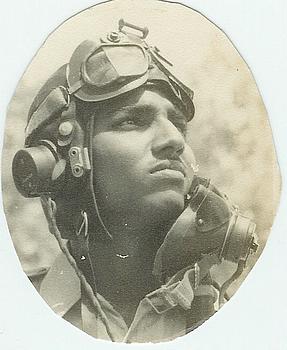
This series of articles and photo albums chronicles the experiences of Muthukumarasami Balan, who joined the Indian Air Force in 1944 to take part in the Second World War. After undergoing training at Begumpet, Ambala and Peshawar, he was posted to No.6 Squadron and subsequently No.4 Squadron. It was with No.4 Squadron that he went to Japan as part of the British Commonwealth Occupation Force. This was just the beginning of a long career in aviation – that would last over four decades!
Early Life
In the late 30s, almost every other day, the Tata Airlines De Havilland Dragon Rapide would fly low over the high school in the city of Villupuram in Tamil Nadu, on its way to Colombo. Watching the lumbering Biplane go through its paces, was a young boy by the name Balan Dandapani. Though a rather odd looking aircraft at that time, watching the regular flights done by the Rapide sparked the first desire for flying for the young boy.
Balan was born on 23rd October 1923. He was the youngest of six children born to V. Muthukumarasami Pillai and R. Navaneedha, both of Cuddalore. Only three of the six survived to adulthood – Balan, his older brother and older sister. His mother, Navaneedha, died when Balan was only one and a half years of age.
Balan spent most of his formative years in Cuddalore and Villupuram. In 1939, he joined Annamalai University at Chidambaram, to pursue his higher studies. He spent the next four years in Chidambaram.
The Second World War was still raging on, there were constant calls given out to eligible young men to volunteer for the Indian Air Force for an emergency commission. The intake of qualified personnel was not in sync with the rapid expansion of the force in light of the war. There was a desperate shortage of well qualified candidates for the IAF. The IAF itself carried out a well publicised campaign to attract bright young men to join as officers. It was only natural that someone with an interest in flying, like Balan, would sooner or later join up.
In 1943, Balan, already driven by his interest in flying, applied to join the IAF as soon as he was of the requisite age. The first round of the process involved a one to one interview with the District Commissioner. The DC would evaluate each candidate for “Officer Like Qualities” (OLQ) and recommend them to attend the screening process at a Selection Board. Balan was one of only two candidates selected on the day he was called, and recommended to attend the Services Board Interview in Bangalore.
SSB Selection
The trip to Bangalore for the services board almost never came off. Balan was given a railway ticket to use to get to Bangalore. However enroute, he missed the connecting train and was stranded at the railway station. The Station master took pity on him and told him that there was another train the next day to Bangalore and Balan could try his luck with that. Till that time, he could spend the night in the waiting room at the station. Balan, though thankful for the help given by the Station master was rueful . He was quite sure that even being one day late would disqualify him from the Services Board.
As luck would have it, the train that Balan missed was routed through a loop line and went off the tracks at Serndanur next to Villipuram.
It was a major disaster and many passengers were casualties. As news of the train accident reached the family in Cuddalore they were crushed. The passenger list confirmed that Balan was on the train to Bangalore. Little did they know that lady luck had smiled on him to make him miss the train. Balan himself knew his family would be worried and the station master was kind enough to send a message to Balan’s family assuring them of his safety.
Balan finally reached Bangalore through the next day’s train. The Selection was to be held at the Madras Sappers Center near the present day HAL Airport. Even though he was convinced that he would be told to go back, it turned out that the Indian Air Force was in no mood to let him go. The authorities at the Services board told him that the interview process was conducted in batches and even though he missed his original batch, he would be accommodated in the next batch that would commence the process in three days time. A very happy Balan turned up three days later and went through the selection process.
Balan remembers that there were about thirty people in his batch at the Interview. The batch had candidates from all over India. Balan in particular remembers a tall and handsome candidate from Punjab, who, everyone was convinced, would be selected due to his connections and demeanor.
When the candidates were given chest numbers to be worn, Balan landed the so-called unlucky number 13!. This provided all the fodder that was needed for the Punjabi candidate – who commenced a barrage of humorous jokes – “Brother, you are sure to get selected – Just see that number! It was made for selection!”
The SSB Selection was as rigourous in those days as it is now. The process took only three days. On the third day, all the candidates were told to assemble in a hall and the numbers of the selected candidates were announced. Only two numbers were announced and one of them was Number 13! Balan vividly remembers the moment “The third day when we assembled in the hall and they were going to announce the numbers, the Punjabi was sitting next to me. And when they announced, Number 13!, the man’s face fell! He was not expecting me to get selected, least of all him being rejected. All the time my leg was being pulled, but I had kept quiet!”.
It should be of note that the selection ratios haven’t changed much over the years. Even today an entire batch of candidates at any SSB would go trough a five day selection process with the final result of only one or two candidates being selected. Quite a few batches end up with none of the candidates qualifying for the Armed Forces.
The two selected candidates were asked to proceed to Delhi for the medical examination. After a long rail journey, along which he had to pay a fine to the ticket authorities for not taking the shortest route on his pass, Balan arrived in Delhi along with the other candidate for the medical examination. It turned out that the other candidate did not clear the medical – and Balan would be the only one selected for the General Duties (Pilot) branch. The other candidate had to content himself by opting for a non-flying branch.
Initial Training Wing, Poona & No.1 Elementary Flying Training School (Begumpet)
Balan reported to the Initial Training Wing at Poona on 6th January 1944. The ITW was located in the Parsi Orphanage near Bund Garden, having moved here from its previous location in Lahore.
The first two months of the training at the ITW was on ‘square bashing’. “Just doing parades and basically going up and down the place” as Balan puts it. The Cadets also brushed up on their ground subjects at this time. Training lasted about four and a half months. Perhaps to build up their ‘air-experience’, the Cadets were also taken to the nearby airfield where a RAF Blenheim Bomber squadron was operating.
In May 1944, the cadets passed out of ITW and were posted out for flying training.
The next stage of basic flying training would be carried out either at the No.1 Elementary Flying Training School (Begumpet) or at the No.2 Elementary Flying Training School (Jodhpur). The batches graduating out of
ITW would alternate between these two training establishments. Balan’s 26th Pilots Course would commence their training at Begumpet, with the No.1 EFTS, towards the end of May 1944. (The subsequent batch, No.27 Pilots Course would go to No.2 EFTS at Jodhpur).
| Tigermoths of No.1 EFTS fly in formation over the old control tower of Begumpet Airfield in Hyderabad. | 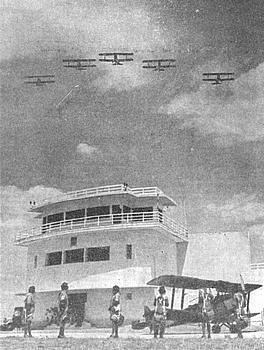 |
Wastage at the EFTS was usually high, nearly 50% of the cadets never successfully completed flying training. In Balan’s batch, only about 26 would get commissions as pilots. Balan’s course mates who later made their mark in the Air Force include Cecil Digby (M in D 65), N B Menon (later KC and VrC), W D McNeil, Dilbagh Singh (later CAS), F S Hussain (Air Cmde – PAF) and Zafar Mahmud (ACM in PAF).
The cadets reported to EFTS officially on the 27th of May, and their flying started soon after. Balan’s first exposure to flying was on May 29th, when Flt Sgt Shirres took him up in a Tigermoth DG461. The flight lasted about 20 minutes.
Flying training at the EFTS was done entirely on the classic Tigermoth, with the help of a mix of RAF and IAF Instructors. The other EFTS used a mix of Tigermoths and Cornells. As noted elsewhere, many of the RAF instructors at EFTS were reserve officers, accepted by the beleaguered RAF when it was short of experienced pilots and instructors. Most of them were senior in age and came from a civilian background and were given war-time emergency commissions.
Balan remembers one particular instructor by the name Clumec. Clumec was a Flight Instructor with a girl friend in Coimbatore. His major interest in the war was to finish off his instructional duties at the earliest and proceed to his girl friend’s place at the first available opportunity. It soon became obvious among the Cadets that whoever was ‘allotted’ to Clumec , the hapless cadet would soon be boarded off to civvy street. The Cadets usually not getting sufficient instruction time in flying from the Instructor.
Balan remembers that a course photograph was taken as soon as they arrived at Begumpet, and the photograph was put up on the wall. Every time a cadet was boarded out, someone would draw a bowler hat on top of the head in the group photo. The trend was always that bowler hats would appear on the cadets allotted to Clumec. And the day the hats were drawn on, Clumec would be nowhere to be seen, obviously he was ‘out of town’ visiting his girl friend! The reverse would also be true, every time they heard Clumec was leaving town, they would check the group photo the next day and sure enough a bowler hat would appear on the cadets allocated to him!
Balan himself fared slightly better, being put under the tutelage of two instructors. One was Flt Sgt Shirres, the other was a middle-aged Flight Instructor by the name Pickersgill. Pickersgill was a civilian pilot before the war, hastily recruited to fill in the serious vacancies in flying instructors in the training facilities. Coming from a civilian background, and with no interest in making a career out of the Air Force, Pickersgill had scant respect for the King’s regulations. This would reflect in his turn out , as according to Balan – ““He was so informal he didnt really care if he was neatly dressed or not – But they couldn’t do much about him as he was old by that time!“.
Pickersgill’s lack of respect for the KRs also showed up in the unauthorized antics he did in the air. Whenever they took off in the Tigermoth, he would spend very little time in flight instruction and spent most of the time buzzing women on the ground. This was a constant source of worry for Balan, while his logbook kept showing more and more dual time, most of it was hogged by Pickersgill for his low flying chases in the aircraft. Balan knew that would need more time to complete his flying syllabus. Balan began to dread his instructional sorties with Pickersgill. Every time they took off, Balan would be praying hard in the front seat that they would not spot any women on the ground!
Pickersgill had another annoying habit. The old airport at Begumpet was quite small to the vast complex it is today. On one end to the southwest was a dhobi ghat. At the other end were a series of grave yards. Everytime Pickersgill and Balan came in for a landing, they would fly over the Graveyard before touchdown. Pickersgill would shout out to Balan over the gosport tube – the only way of communication between them – point downwards to the graves and say “Undershoot and that is where you are going to land up!“.
This was enough to put Balan on notice. Whenever he used to execute the landing, He used to come in high and almost overshoot on landing. Pickersgill now chided Balan for coming in too high – and for being frightened of low flying!
Flying training at EFTS lasted another two months. Balan flew with a host of other instructors, including Fg Offr Kelly, Flt Lt Rivington, Fg Offr Phillips, BK Krishna Rao and Rabbani, and W/O Guthrie. He also did cross country flying (Check done by Pilot Officer Dougal). The final flying test was done by Squadron Leader Strang .On 21st June , 1944, Balan’s day started with a flight with Flt Sgt Shirres. At the end of the sortie, Fg Offr Chitamber, another instructor gave the Solo check ride to Balan before sending him off again for the third flight of the day – his first solo. Balan’s solo in Tigermoth EM960 lasted just 15 minutes, but it was that first step in earning his wings and what would be an eventful flying career that would last decades.
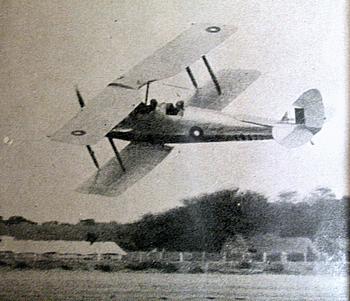 |
c1945 – A De Havilland Tigermoth is put through its paces by an Instructor – Pilot Duo. This particular Tigermoth, in SEAC markings, is not from an EFTS but from the SFTS at Ambala. |
No.1 Service Flying Training School, Ambala and No.151 Operational Training Unit, Peshawar
EFTS Training ended in August 1944 and the remaining cadets proceeded to Ambala for Advanced Training. The day of their arrival at No.1 (India) Service Flying Training School, 4th September 1944 was also the day the cadets of No.26 Pilots Course got their commissions. The newly minted Pilot Officers continued their training on the Harvard, and on a slightly tougher syllabus. The jump from the Tigermoth to the Harvard was quite significant – in terms of the sheer power of the Harvard, features like an enclosed cockpit, retractable undercarriage, Radio Telephony, as well as the speed and handling of the aircraft made it an altogether new game.
No.1 SFTS was already the centerpiece of the IAF’s Training establishments. In addition to the advanced flying training for pilots, there were training programs for Navigators, Airmen training in various technical trades, as well as Target Towing.
In contrast to Begumpet, Ambala was the hotbed for various aircraft types milling around. Oxfords, Ansons, even a couple of Vultee Vengeances could be seen around the station. The pupils exchanged various stories that they had heard about the aircraft. They heard about the Cornell, and how it was ‘not much of an aircraft’ and how it was underpowered. The Anson , which would behave as an elephant. Then there was the anecdote of the Vengeance tail gunner – whose rear guns jammed and who, in a panic to clear the jam managed to bend the cocking handle!
Most of the instructors were RAF, but there were a couple of exceptions. The elder of the Stidston brothers, Raymond, was there as one of the instructors. He would be the one who would provide instructional duties to Balan most of the time. The other was W/O Dowlen of the RAF.
Advanced Training completed in about four months and on 8th January, the cadets went to No.151 Operational Training Unit at Peshawar for training on the Hurricane. Unlike other Pilots Courses, the 26 PC never had a formal wings ceremony. The pilots were handed their wings in the mess. In Peshawar, they learnt the operational tactics of a combat unit, formation flying, air combat etc. Armament Training and night flying also formed an essential part of the training.
The introduction to the Hurricanes also posed a significant hurdle for the pupils. There were no ‘type trainers’ for the Hurricane as they exist for fighters of today. There would be no luxury of an instructor accompanying the trainee pilots and looking over their shoulders for the first flights. All knowledge on the type had to be learnt by the pupils on the ground, and in the air. As Balan puts it
“Those days the fellows who were taken had a choice to chose the best available. We had some initiative to do something. Those days, wartime, you would just see the aircraft on the ground, go through the hand book, taxi around a little bit and then you sit and take off – without the benefit of a trainer version.
Inspite of not having previous help to fly the new aircraft, our accidents were also less. “
But it is not to say that the flying at the OTU went without incident. There were other courses still winding up their training at Peshawar. And within two days of them joining the Officers were given the news of the loss of Pilot Officer Chunnilal Ray, who went on a sortie to the Mardan area and crashed into the hills. (Balan’s course itself had one fatality – Plt Offr D S Greenhorn).
It was in the middle of May that the Operational training was completed at 151 OTU. The time had now come for the pupils to be sent on their first postings to operational units.
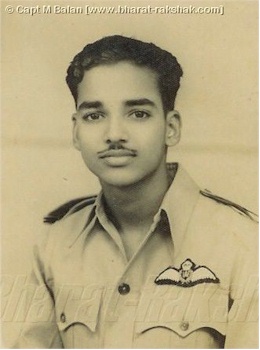 |
Pilot Officer Balan – proudly displaying his pre-1945 IAF wings. |
Left : In flying suit and boots – in Japan
6 Squadron, Kohat , May 45 to July 45
By that time the war in west was over. Even in the east, the Japanese were on the run. Rangoon had been recaptured on the 3rd of May, and it was a matter of time before the whole of Burma would be in the hands of the Allies. Many of the Units that had taken part in the Arakan Campaign were now recuperating back in India.
Balan’s training at Peshawar officially ended on 22nd May, and two days later he reported to Kohat on posting to No.6 Squadron – then under the command of Sqn Ldr Jangoo Engineer. He was part of a batch of four officers, the other three being JF Lazaro, LS Edwards and B Ghosh.
Freshly minted out of the OTU, Balan remembers arriving at the squadron to hear the stories of his predecessors. While the combat record of No.6 Squadron, under the legendary Mehar Singh has been quite well known and indoctrinated to all new comers, these tales were superceded by the stories of the six officers who had just returned from Canada and were posted to No.6 Squadron.
“When we were posted to No.6 Squadron, at Kohat, we arrived to hear the colorful stories of the six fellows who had just returned from Canada. They were sent there for Flying training (as part of the British Commonwealth Air Training Plan) , these included Manivelu, JJ Bouche, Lazarus, Stanley Santiago, Bahadurji – there were six of them. Well they went there and painted the town red, they thoroughly enjoyed themselves there and came back with a reputation! – Which ended any further talk of Indians being sent to Canada for training!”
No.6 was under the command of Jangoo Engineer at that time, and had been on the Frontier ‘Watch and Ward’ duties for just about an year.
Balan was able to avail himself of leave for the first time in about a year, and in June he took a break to visit his family. He returned back shortly and commenced his duties – flying on the Hurricane II on the frontier, he recollects that it was very limited, but it took him to the other frontier airfields like Miranshah and Razmak. Before he could get comfortable with the Squadron, he got a fresh set of posting orders – He would be posted away from No.6 Squadron. On July 14th, Balan took the train to go to Madras. He would have to make his way to Yelahanka and reported to No.4 Squadron.
4 Squadron – Yelahanka (August 6th , 1945 – April 29th, 1946)
The day Balan officially reported to No.4 Squadron was significant in its own right – it marked the dropping of the first atomic bomb by the Americans on the Japanese city of Hiroshima. And with that , the prospects of a long war ahead would be drastically cut short. The ‘super bomb’ would ensure that the fighting would soon come to an end.
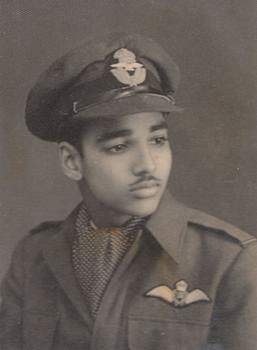 No.4 Squadron had been in operations in Burma till April 45. It had distinguished itself in operations under its Kiwi CO, Sqn Ldr G S Sharp, and notched up a respectable tally of Awards. One DSO to the CO and Four DFCs were awarded to the pilots of the Squadron. It had since been pulled back and was earmarked for conversion onto Spitfire VIIIs. The Squadron was temporarily under the command of Flight Lieutenant Jagdev Chandra, who had taken over a couple of days earlier from the outgoing British CO Boyd-Berry. On 12th August, Sqn Ldr E W Pinto arrived to take over command.
No.4 Squadron had been in operations in Burma till April 45. It had distinguished itself in operations under its Kiwi CO, Sqn Ldr G S Sharp, and notched up a respectable tally of Awards. One DSO to the CO and Four DFCs were awarded to the pilots of the Squadron. It had since been pulled back and was earmarked for conversion onto Spitfire VIIIs. The Squadron was temporarily under the command of Flight Lieutenant Jagdev Chandra, who had taken over a couple of days earlier from the outgoing British CO Boyd-Berry. On 12th August, Sqn Ldr E W Pinto arrived to take over command.
The Squadron’s conversion to the Spitfire had just about started when Balan was posted to the unit. As a junior pilot he had to wait for his turn to come up. His initial flying with the Squadron was on the lone Harvard (FE463?) and the older Hurricanes. A week later on August 13th, he flew his first sortie on the new Spitfire VIII, which lasted an hour.
Once again, flying the Spitfire was a matter of preparing on the ground through the pilot notes, doing a few taxi runs and going off on the first flight all alone. Balan was one of the two new pilots (the other being S P Sen) who finished conversion on the Spitfire over the next few days. The conversion would encompass not just handling the aircraft, but also formation flying, cross-country navigation, low flying and aerobatics.
4 Squadron at that time had a heavy composition of commonwealth personnel, with the majority being British. However with the War almost over (the Japanese surrender being signed on August 15th) the British personnel of the Squadron were posted out. In a short period of time, the Squadron went completely Indian.
Being only the second unit in the Indian Air Force to re-equip with the Spitfires, and the only one based at India at that time, the Unit was called upon to test various new techniques in bomb delivery, in particular dive bombing. It was a futile attempt in Balan’s opinion – only months earlier, Plt Offr R G Buchanan was killed on a similar sortie over an armament range.
“They wanted to try out the idea of Dive Bombing, so they said, use Spitfires for the (dive) bombing. So we would go over target , flip over on our back, pull the stick and come straight down in a dive from 10,000 feet. At about 5000 feet, you would release the bombs.
Now this trial was done by the IAF. The RAF in a way made us guinea pigs. One pilot even died. He went into the ground during the flight. By the time you are at 5k feet, you are pulling the aircraft up, the G becomes 7. and there is a danger of becoming unconscious. The staff were playing with us – lets try it out with the Indians and see if it is okay for the usage.”
It was towards the end of August that the Squadron was inspected by Gen Sir Claude Auchinleck, Commander in Chief, India. The General met with the officers and airmen after the event and indicated for the first time that the squadron may move to the ‘areas of occupation’ and thus become the first RIAF unit to go overseas beyond the immediate battle areas around India. This put a new life into the Squadron – the buzz was confirmed the very next day during a visit by Air Chief Marshal, Sir Keith Park, who mentioned that he hoped to visit the Squadron next time ‘in the land of the rising sun’. The flurry of visitors continued. In October, the squadron was paid a visit by AVM C A Bouchier, AOC Designate of the BCOF, Japan.
The squadron flew many army cooperation sorties over the next weeks, cooperating with the Southern Army. A significant amount of time was spent in formation flying. The Squadron chalked up a way to fly a formation in the form of the digit ‘4’.
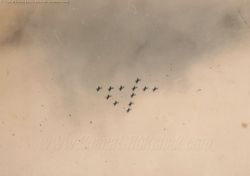 |
Aircraft of No.4 Squadron fly in formation in the shape of the digit “4”. See also No.4 Squadron in Japan (1946-47) – The Aircraft |
Conversion to Spitfire XIVs
The Squadron commenced conversion to the much powerful RR-Griffon engine Spitfire XIVs towards the end of December 45. The last day of the month, three of these aircraft arrived from Bombay. The initial Spit XIVs arrived without the wing tips and were later fitted with the elliptical tips.
The Spitfire XIVs presented a set of new issues to the pilots under training. The aircraft’s Griffon engine’s crankshaft rotated in the opposite direction of the Merlin, and the usual ingrained habit of applying starboard trim to the rudder only increased the swing on take off. Pair take offs on the XIVs were an exercise that required hard concentration from the pilots. The Griffon engine also resulted in a longer nose to the aircraft, and thus decreased visibility across the nose for the pilot. As Balan explain, about the challenges of the take off and landing regimes on the XIVs :
“The Spitfire XIV had the Griffon engine which had more than 1600 hp available. We used to take off, two aircraft normally, side by side. We had to be very careful. If you suddenly open up the throttle, the aircraft will swing. The torque of the rotating propeller will hit you. Max rotation of the propeller will be there and it hits on one side of the tail and the aircraft will start veering to the right side.
So when taking off with two or three aircraft together in formation, you have to open up very slowly. Slowly you start increasing the speed so that the airflow will help you keep it straight. Because of airscrew torque, if you open suddenly, you won’t be able to control it with full rudder and opposite stick. You have to let the airflow on the fuselage do the work of keeping the aircraft straight.
Landing is difficult. With the big engine you can’t see over the nose. We’d bank the aircraft and do a steep turn and line up with the runway. Only in the last minute will you line it up and land. You can’t see the runway when you are in line with it. The engine will completely block the full runway. You won’t know if you are far to one side or the other side.”
Over the next month, the conversion proceeded without event. Most of the Mk VIIIs were allotted to No.2 Squadron at Kohat and the aircraft were ferried by the squadron pilots in the third week of January 1946. More Spitfire XIVs were received in the month.
The elliptical wing tips were fitted. The aircraft were also stripped of their camouflage and painted silver for their impending move to Japan.
The move to Japan started in late February 1946. An advance party of 3 Officers and 72 Ors under Fg Offr Anthony proceeded to Bombay to embark on the ship “M V Dunera”. After many trials and tribulations the Advance Party reached Iwakuni in
Japan on 30th March 1946.
In early March 1946, Balan was temporarily asked to proceed to Kajamalai, Trichy where No 8 Squadron was operating. Here he met the other officers of the Squadron including Fg Offr Thangamuthiah and Fg Offr Mohite whom he befriended right away. Sadly, Muthiah went on a local sortie within a few days of Balan’s arrival, when the engine of his Spitfire XIVe cut in mid flight. He was killed attempting a belly landing at a level crossing. He was a wonderful young man, and with the pall of his new friend’s sudden death hanging over him, Balan was grateful to be re-posted to Yelahanka (after only about 12 days in Trichy), and rejoined No 4 Squadron.
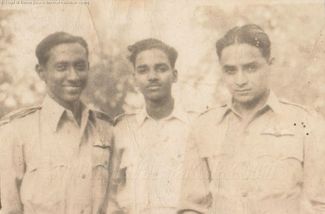 |
At Trichy – Kajamalai . L-R: F/O Clarence Thanga Muthiah of 8 Squadron (who died in a Spitfire crash in Trichy a few days after the photo was taken), Balan and F/O Mohite, a Maharashtrian pilot. |
Soon after, the main party of No.4 Squadron commenced its move for Japan on 1st April 46. The ground personnel proceeded to Cochin by train, to embark on the HMS Vengeance. The air party flew their Spitfires to Cochin the next day. All the aircraft with the exception of one arrived safely at Cochin. The aircraft were then towed to the wharf, which was about half a mile from the airstrip and carefully loaded onto the aircraft carrier. HMS Vengeance sailed into Iwakuni, Japan on the 26th of April 1946.
Less than four days later, the pilots of the Squadron put up their first formation flight – Ten aircraft led by Sqn Ldr Noor Khan flew in the now signature digit ‘4’ formation.
Move to Japan
Balan was one of the 15 officers who remained at Yelahanka to sail with the rear party. To this rear party was entrusted the task of moving tons of ground equipment, MT Vehicles, tools, stores etc that were necessary for the Squadron operations. The rear party consisting of 15 officers and 111 Ors left Yelahanka for Bombay on 15th April. Flt Lt HSR Gohel led this party. This party embarked on the MV Dunera on the 28th and reached Japan on 18th May. The contingent then took an overnight journey to reach Miho – where most of the Squadron was now based.
At Miho, No. 4 Squadron had 19 Spitfires and 1 Harvard on strength. Their main task was to conduct patrols over the towns of Okayama, Hiroshima, Shinaue, and Totori, as well as Coastal Patrols to check Martime traffic in the area. Balan recalls:
“We used to go for morning and evening patrols. Take off and we would go 100 miles into the sea, where there was a group of islands known as Oki Islands.. It was the usual dawn patrol. We used to look for any ships present and all the maritime traffic in that area.”
The flying was mostly routine. Every once in a while, the officers and men got to go out on leave on pre-arranged picnic trips or outings. Trips were organized for the officers and airmen to various nearby places. The destinations included local attractions like Mount Daisen or Takuma bay. The pilots were also taken to the razed town of Hiroshima, the pilots eagerly went along, as Balan remembers, and with none of the fears of radiation that are usually raised today.
“We went to Hiroshima where they dropped the atomic bomb. The whole area was burnt out as if an amount of Incendiaries were dropped. We went to the place where the burnt out dome is today. We never knew anything about things like radiation, sickness etc. For us it was more of an Incendiary bomb that burned the whole city than a blast. A whole lot of buildings and people were burnt out by the bomb.”
Once in a while, the pilots also got to go on a longer break. Balan got to go to Tokyo on a one week all expenses paid Holiday, visiting places like Marumishi, Kamakora etc. The official leave period arranged by the BCOF included the stay at the famous Kawana Hotel South of Tokyo. With its beautiful lawn, 18 hole golf course, and the various amenities, it was something that was beyond the imagination of the Indian Officers. As Balan states.
“If you have to go to that Hotel for one week, you will have to pawn your home to stay there! But in our time, the BCOF were paying for the whole stay!”
Regular flying was carried out throughout their stay. One of the memories of that time was taking part in the 4th of July Flypast over Tokyo in 1947. This was actually done on 5th July and Balan flew in Spitfire TZ165 on that day. It was the last flight he undertook over Japan. The tenure of the Squadron was coming to an end, and towards the end of July, No.4 Squadron left their Spitfires and were shipped back to India.
Last Days in the RIAF
Balan returned with the Squadron to India in October 47, just about when the Kashmir Operations were breaking out. 4 Squadron, now without any aircraft, was temporarily based at Chakeri, Kanpur. Though it was earmarked to receive the Tempest IIs, it would take some time. For many of the pilots who returned from Japan, it seemed as if there was nothing to do.
“Once we came here, we didn’t have much to do, they posted all of us to different places. I was posted to Palam airfield control. Digby was posted to Agra, and they dispersed the whole lot of us.”
A major personal event of note at this time was his marriage to Thulasi on 14th November, 1947. In December 47, Balan was posted to No.3 Wing Palam – when the operations for Kashmir were underway. It was a staff posting, and Balan got to see many of the operations being undertaken at close level. One of the many inspiring officers he would come in contact with was Air Commodore Mehar Singh, then in charge of No.1 Operations Group. Mehar Singh left quite an impression on Balan.
“I knew Mehar Singh when I was in Delhi. He was an Air Commodore, and he had a nothing but contempt for the air force. He was a good pilot. He used to merrily crack jokes and all. And they found it difficult to keep him under check, because there were no rules or regulations as far as he was concerned.”
About the same time, Balan felt he had other opportunities to pursue. The War time emergency commissioned officers started to be released. Balan didn’t like the flux in which the Air Force found itself at that point. He duly secured his release on April 26th, 1948 and literally stepped out into ‘civvy street’.
Civil Career
Once out of the Air Force, the entire world of civil aviation was lying open to the young man. With the end of the Second World War, Civil Aviation in India was booming, encouraged by both a proliferation of war surplus aircraft as well as airfields constructed across the length and breadth of the country.
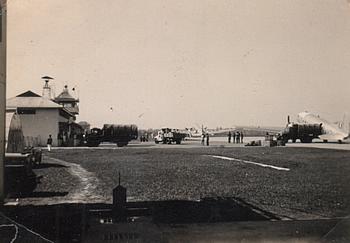 |
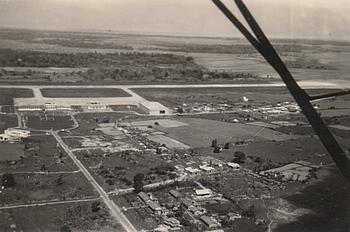 |
| Balan’s Civilian flying career took him across the length and breadth of the country’s airfields and aircraft, as exemplified by the photographs of these airfields in his collection. | |
Balan’s first assignment was to join up as the Assistant instructor at Jakkur in Bangalore, where he also flew as the Asst Captain on the Dakota aircraft of the Mysore State Maharaja. The Maharaja had lent his aircraft to the Government of India and on many an occasion, Balan got to fly several VIP’s around, including Sardar Vallabhai Patel. Balan then became the Chief Instructor at Bhubaneshwar’s Orissa Flying Club, followed by Chief Instructorships at Coimbatore Flying Club, Coimbatore and Gauhati Flying Club in Assam. During his stint at Orissa, Balan came into contact with Biju Patnaik, then a dare devil pilot as well as a seasoned politician – a rare combination in India.
Throughout his career, Balan remained a hard working man, sacrificing much to give his two sons and daughter every advantage and comfort in life. He was ably assisted in all his ventures by his wife. Balan’s flying career lasted nearly four decades till he retired from flying in the 80s. Today he is settled in Chennai along with Mrs Thulasi Balan. Together they celebrate 60 years of a happy marriage.
Acknowledgements:
Mrs. Bhuvana Chandra for arranging the Interview with Capt M Balan
Capt M Balan and Mrs Thulasi Balan for patiently spending hours with the author, sharing their memories and thoughts!
Epilogue:
Capt M Balan passed away on the morning of 25th November 2022 at 0621 Hrs. He was 99 years old. His wife Mrs Thulasi Balan had unfortunately pre-deceased him by about six weeks. At the time of his demise, his daughter Dr Bhuvana Chandra was by his side. Rest in Peace Sir!
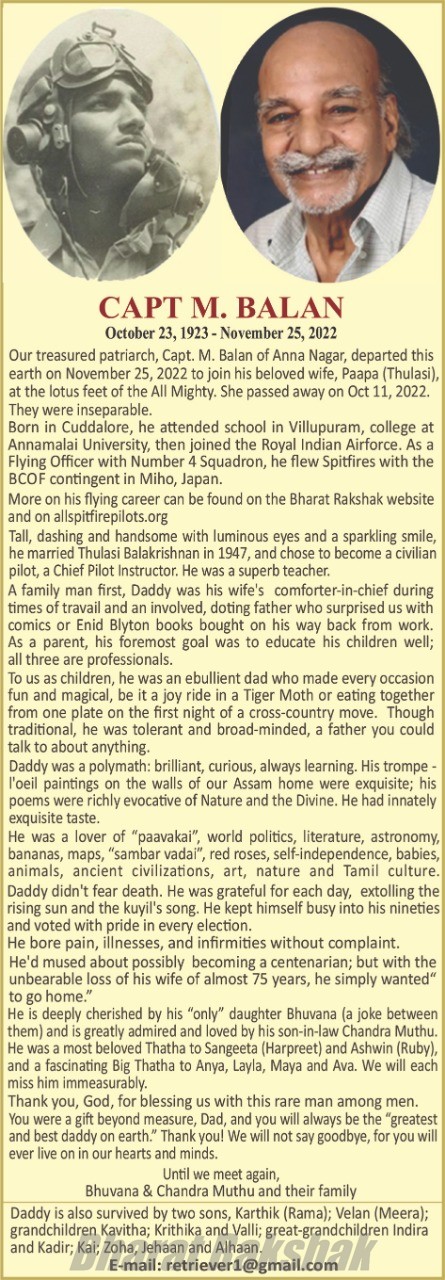
Updated Copyright Notice: On the passing of Captain Balan, the copyright of the Images that are watermarked in Captain Balan’s name are now assigned to Mrs. Bhuvana Chandra, Captain Balan’s Daughter. These include the images found in the Galleries at https://www.bharat-rakshak.com/IAF/Galleries/History/WW2/Balan01/ and https://www.bharat-rakshak.com/IAF/Galleries/History/WW2/Balan02/
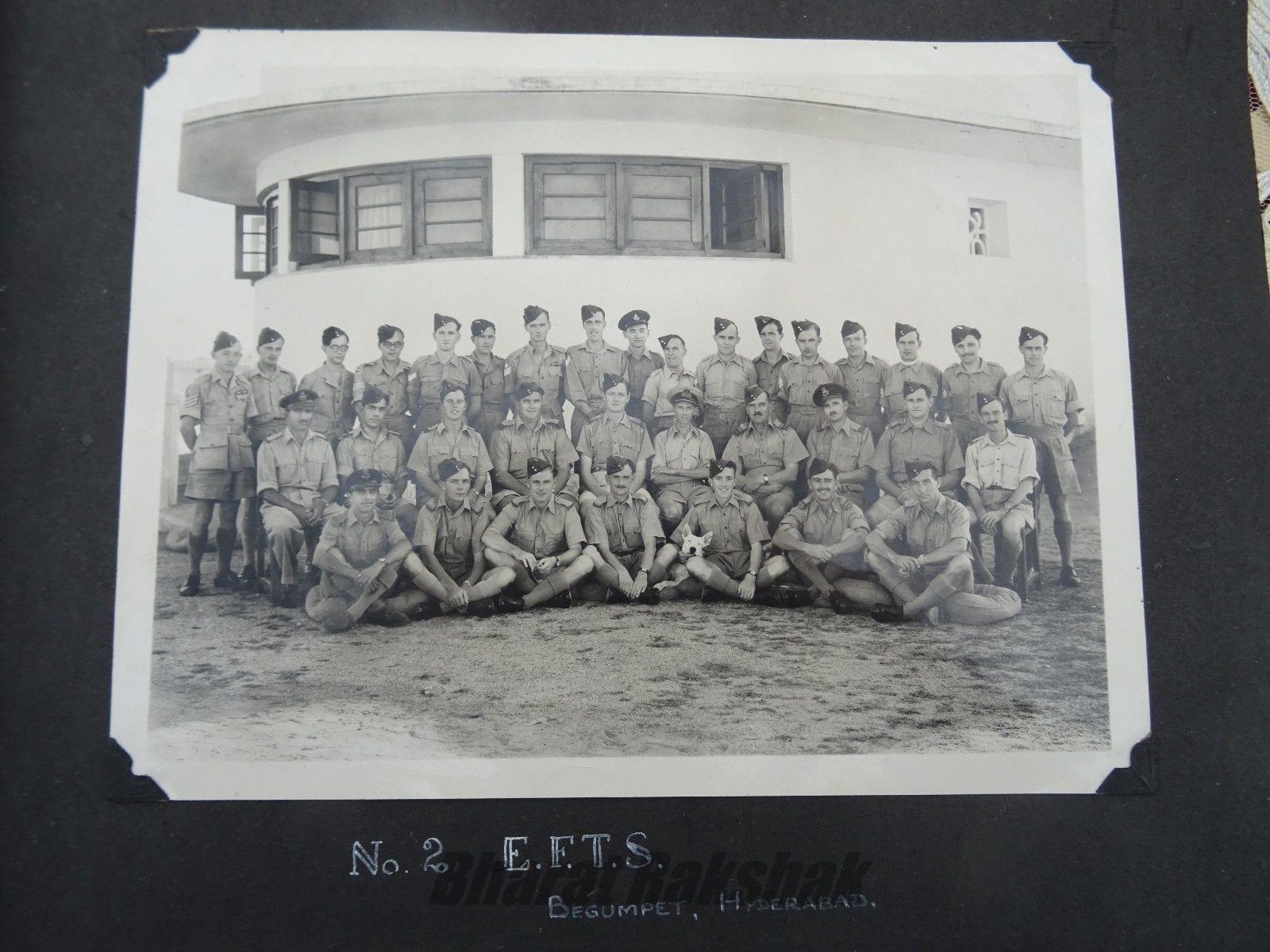
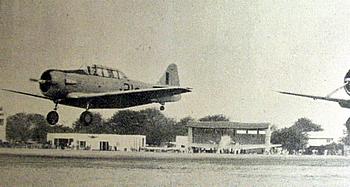
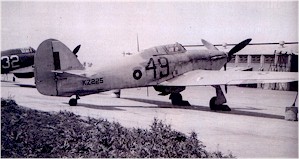
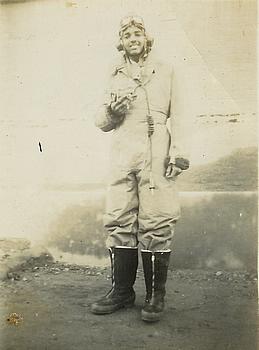
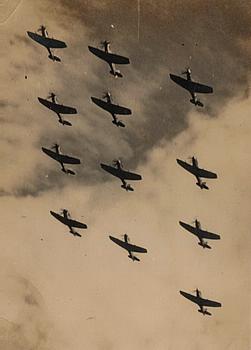
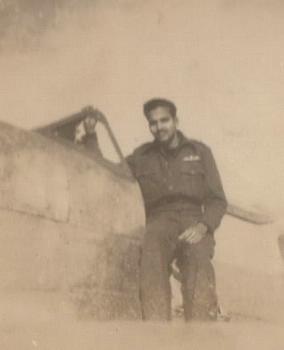
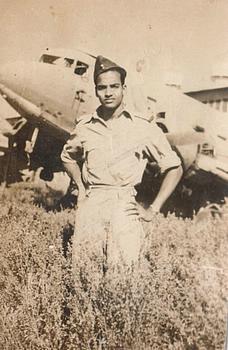
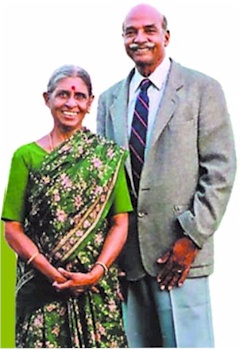
Thank you, Jagan, for your kindness and integrity.
Thank you, Jagan, for your kindness and integrity and for your always ready help. My parents and I were honored to have you touch our lives through your site and through the time you spent with them in person.